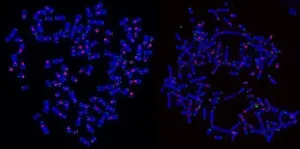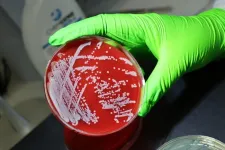(Press-News.org) INDIANAPOLIS – Due to the physical contact nature of their occupation, the elite athletes of the National Football League (NFL) often experience pain. However, an analysis of 2021 and 2022 data from the National Football League Prescription Drug Monitoring Program shows that team members in those two years were even less likely than both the general U.S. population and males of similar age living in the U.S., to have a prescription for an opioid pain medication.
The study found that less than 3 percent of pain medications prescribed to the athletes who played in one or both of the two seasons were for opioids. Slightly more than 86 percent of the pain medications were nonsteroidal anti-inflammatory agents (NSAIDs) such as ibuprofen, naproxen, diclofenac or celecoxib – which are currently the preferred first-line pain medication recommended for pain.
“NFL athletes are exposed to very physical contact and to the development of pain during or after games due to injuries. There’s always been a concern from a safety and health perspective about what are they using to treat their pain,” said Regenstrief Institute and Indiana University School of Medicine researcher-clinician Kurt Kroenke, M.D., a study co-author and national leader in the field of medical symptoms.
“The good news is of all medicines prescribed to league players for pain, opioids account for only 3 percent. Moreover, only 10 percent of NFL athletes received even a single prescription for an opioid during a one-year period. I think there's been much greater attention to what can be done in the training room for NFL athletes for their injuries and pain that doesn't rely on medicines.”
Dr. Kroenke is a consultant to the National Football League-National Football League Players Association (NFLPA) Joint Pain Management Committee, whose members are appointed by the NFL and the NFLPA. The committee’s goals are to address the challenges of pain management for current NFL players and to facilitate research to better understand and improve potential alternative treatments.
A total of 3,142 players had a signed contract with at least one NFL team during the 2021 season. 14,903 prescriptions for pain medications issued to 2,207 of these men by either a team doctor or external medical providers were entered into the monitoring program database.
During the 2022 season, there were 14,880 prescription pain medications, slightly fewer than the prior year, issued to 2,189 players (out of a slightly larger population of 3,152 with signed contracts) entered into the monitoring program database.
In 2021 and 2022 a total of 576 players were prescribed opioid medications, indicatingthat most players (more than 90 percent) did not receive any opioid prescriptions.
Opioid prescriptions for NFL players in 2021 and 2022 contrast significantly with the findings of a survey of retired NFL players, reported in 2011, which showed that 52 percent had used prescription opioids during their career and of those who had used opioids, 71 percent reported misuse.
Since that time, Centers for Disease Control and Prevention (CDC) guidelines for prescribing opioids have changed significantly to reduce risks of opioid use disorder, overdose and death.
In 2019 the NFL and the NFLPA established the prescription drug monitoring program to track prescriptions of scheduled substances and other prescription medications. 2021 and 2022 were the first two years of standardized and robust data in this centralized electronic medical record system.
“The NFL-NFLPA Pain Management Committee is always looking to improve the health and safety of the players, and the Prescription Drug Monitoring Program aims to do that by educating medical staffs about their prescribing habits. We are encouraged by these early results but we hope to limit opioid prescriptions even further in the future,” said paper co-author Kevin Hill, M.D., MHS, director of the Division of Addiction Psychiatry at Beth Israel Deaconess Medical Center, an associate professor of psychiatry at Harvard Medical School and co-chair of the NFL-NFLPA Joint Pain Management Committee.
“Professional football is a very physical sport. But anyone who watches professional hockey or NBA basketball or big league soccer and even college and high school sports, realizes how these players also are prone to injuries and pain,” said Dr. Kroenke. “I think how we treat pain safely, using opioid pain medications very infrequently, applies across all sports.”
“Pain Medication Data from the 2021 and 2022 National Football League Prescription Drug Monitoring Program” is published in Current Sports Medicine Reports, a publication of the American College of Sports Medicine.
Authors and affiliations as listed in the paper:
Hill, Kevin P. MD, MHS1,2; Kroenke, Kurt MD, MACP3; Wasserman, Erin B. PhD4; Mack, Christina PhD, MSPH4; Ling, Geoffrey S.F. MD, PhD5,6; Mayer, Thom MD6; Solomon, Gary S. PhD7,8; Sills, Allen MD, FACS7,8
1Division of Addiction Psychiatry, Beth Israel Deaconess Medical Center, Boston, MA
2Department of Psychiatry, Harvard Medical School, Boston, MA
3Indiana University School of Medicine and Regenstrief Institute, Indianapolis, IN
4IQVIA, Research Triangle Park, NC
5National Football League Players Association, Washington, DC
6Department of Neurology, Johns Hopkins School of Medicine, Baltimore, MD
7National Football League, New York, NY
8Department of Neurological Surgery, Vanderbilt University School of Medicine, Nashville, TN
Kurt Kroenke, M.D., MACP
In addition to his role as a research scientist with the William M. Tierney Center for Health Services Research at Regenstrief Institute, Dr. Kroenke is an Indiana University Indianapolis Chancellor’s Professor and a professor of medicine at the Indiana University School of Medicine.
END
Study finds opioid pain medications very infrequently prescribed to NFL players
2025-01-13
ELSE PRESS RELEASES FROM THIS DATE:
Wrong place, wrong time: Why Zika virus hijacks a protein needed for brain growth
2025-01-13
The mosquito-borne Zika virus is known for causing microcephaly, a birth defect in which abnormal brain development results in a smaller-than-expected head. A new study published Jan. 13 in mBio shows that the Zika virus hijacks a host protein called ANKLE2, which happens to be important for brain development, to assist its own reproduction. Because Zika, unlike most related viruses, can cross the placenta, this can have disastrous consequences in pregnancy.
“It’s a case of Zika being in the wrong place at the wrong time,” said Priya Shah, associate professor in the departments of Microbiology and Molecular ...
The new age of infrastructure maintenance using data from space
2025-01-13
The concentration of the population in cities is accelerating, and difficulties in maintaining various infrastructures are arising due to extreme weather. Extensive infrastructures like waste landfill facilities face significant challenges due to the difficulty for managers to stay on-site or access them. These maintenance issues are resulting in various problems, including environmental pollution.
To solve these issues, Korea Institute of Civil Engineering and Building Technology (KICT, President Sun Kyu, Park) has developed a cost-effective and high-efficiency maintenance technology using satellite ...
CNIO and CNIC research identifies a key protein for ‘burning’ fat
2025-01-13
This work reveals a new mechanism by which brown fat is converted into heat, and which protects from pathologies associated with obesity.
The MCJ protein is key to the fat burning mechanism now identified, making it a promising target for treating obesity, according to the authors in Nature Communications.
The research is led by Guadalupe Sabio, from Spain’s National Cancer Research Centre (CNIO), and Cintia Folgueira, from both CNIO and the National Centre for Cardiovascular Research (CNIC).
Obesity, which affects 650 ...
‘True food’ research database offers rankings for 50,000 processed foods
2025-01-13
‘True Food’ Research Database Offers Rankings for 50,000 Processed Foods
The database, developed by researchers at Mass General Brigham and made available to the public, sheds light on the availability of processed foods at different grocery stores, highlighting the need for more understanding and regulation of the foods offered
A new study by investigators from Mass General Brigham provides information to empower consumers and policymakers about the degree of processing of the foods available at three large grocery retailers. Using an algorithm, the researchers analyzed ...
Mystery solved: how tumor cells die after radiotherapy
2025-01-13
Scientists at Children’s Medical Research Institute (CMRI) have solved a big mystery in cancer research – why cells die in different ways following radiotherapy. This surprising finding opens up new opportunities to improve treatment and increase cure rates.
The findings were published in Nature Cell Biology by first author Dr Radoslaw Szmyd of CMRI’s Genome Integrity Unit, which is led by Professor Tony Cesare.
Radiation therapy (also called radiotherapy) is a critically important type of cancer treatment. Scientists have struggled for decades to understand why radiation therapy kills cells from the ...
Bacterial survival genes uncovered using evolutionary map
2025-01-13
The most detailed study to date on the mechanisms by which a common type of bacterium, Staphylococcus aureus, adapts to living on the human body could help improve the prevention, diagnosis, and treatment of certain infections.
The study, from the Wellcome Sanger Institute, the University of Cambridge, the Institute of Biomedicine of Valencia (IBV) at the Spanish National Research Council (CSIC) and their collaborators, involved using the genomes of thousands of S. aureus isolates cultured from the human nose and on the skin to investigate which genes are important for the bacteria to adapt and persist.
Published today (13 January) in Nature Communications, ...
Sodium-ion batteries need breakthroughs to compete
2025-01-13
Legions of battery engineers and their supporters have sought for years to build batteries cheaper than the dominant lithium-ion technology, hoping to capture some of lithium-ion’s $50 billion-a-year and growing market. The latest darling contender among researchers, startups, and venture capitalists – sodium-ion batteries – has received much attention after COVID-induced mineral supply chain challenges sent lithium prices on a wild ride. Still, achieving a low-cost contender may be several years away for sodium-ion batteries and will require a set of technology advances and favorable ...
Tumor DNA in the blood can predict lung cancer outcome
2025-01-13
Scientists from the Francis Crick Institute, UCL, UCLH and Personalis have found that a test to detect circulating tumour DNA can predict lung cancer outcome in a Cancer Research UK-funded study.
Circulating tumour DNA (ctDNA) is fragments of DNA released into the blood by tumours. It’s known to be important for disease prognosis but can be difficult to measure precisely.
In research published today in Nature Medicine, Crick and UCL scientists worked with Personalis to test a platform called NeXT Personal, which can detect very small amounts – 1 part per million – ...
New study unveils breakthrough in understanding cosmic particle accelerators
2025-01-13
Scientists have come a step closer to understanding how collisionless shock waves – found throughout the universe – are able to accelerate particles to extreme speeds.
These shock waves are one of nature's most powerful particle accelerators and have long intrigued scientists for the role they play in producing cosmic rays – high-energy particles that travel across vast distances in space.
The research, published today in Nature Communications, combines satellite observations from NASA’s MMS (Magnetospheric Multiscale) and THEMIS/ARTEMIS missions with recent theoretical advancements, offering a comprehensive new model ...
Previous experience affects family planning decisions of people with hereditary dementia
2025-01-13
Living in a family where there is genetic risk for dementia significantly affects choices about having children and how to parent, finds a new study led by UCL researchers.
The research, published in the Journal of Genetic Counselling, interviewed 13 people – both parents and non-parents – who are at risk of developing familial frontotemporal dementia (fFTD).
This form of dementia often begins in mid-life and is characterised by behavioural and personality changes. Children of an affected parent are at 50% risk of inheriting the gene that causes the disease.
People in affected families fall into three groups: people who don’t choose to find out whether ...





